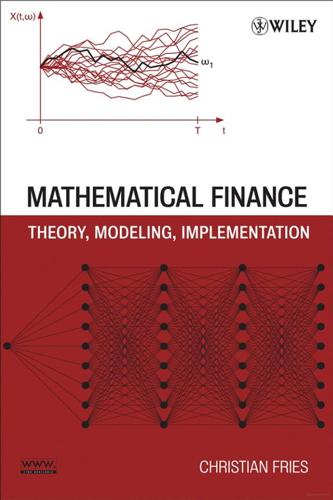
Mathematical Finance: Theory, Modeling, Implementation
by
Christian Fries
Published 9 Sep 2007
The question on how to obtain a set of factors or reduce a given set of factors to the relevant ones is discussed in Appendix A.4 and A.5. C| 2.8. Martingales Definition 46 (Martingale): q The stochastic process{X(t), Ft ; 0 ≤ t < ∞} is called a martingale with respect to the filtration {Ft } and the measure P if X s = E(X(t) | F s ) P almost sure , ∀0 ≤ s < t < ∞. (2.6) If (2.6) holds for ≤ in place of =, then X is called sub-martingal. If (2.6) holds for ≥ in place of =, then X is called super-martingal. y Lemma 47 (Martingale Itô-Processes are drift free): Let X denote an Itô process of the form dX = µdt + σdW under P RT with EP 0 σ2 (t) dt 1/2 < ∞. Then we have X is a P martingale ⇔ µ=0 (i.e. X is drift free). 2.8.1.
…
X is drift free). 2.8.1. Martingale Representation Theorem Theorem 48 (Martingale Representation Theorem21 ): Let W(t) = (W1 (t), . . . , Wm (t))T denote an m-dimensional Brownian motion, FRt the corresponding filtration. Let M(t) denote a martingale with respect to Ft with Ω |M(t)|2 dP < ∞ (∀ t ≥ 0). Then there exists a stochastic process g (with g(t) belonging to the class of integrands of the Itô integral) with Z t M(t) = M(0) + g(s)dW(s) P almost sure, ∀ t ≥ 0. 0 21 See [25], §4.3 and [18], Theorem 4.15. 52 This work is licensed under a Creative Commons License. http://creativecommons.org/licenses/by-nc-nd/2.5/deed.en Comments welcome. ©2004, 2005, 2006 Christian Fries Version 1.3.19 [build 20061210]- 13th December 2006 http://www.christian-fries.de/finmath/ 2.9.
…
. ©2004, 2005, 2006 Christian Fries Version 1.3.19 [build 20061210]- 13th December 2006 http://www.christian-fries.de/finmath/ CHAPTER 2. FOUNDATIONS Definition 55 (Previsible Process): q Let X denote a (real valued) stochastic process on (Ω, F ) and {Ft } a filtration on (Ω, F ). The process X is called {Ft }-previsible, if X is {Ft }-adapted and bounded with left continuous paths. y Definition 56 (Integral with respect to a semi-martingale as integrator22 ): Let Y denote a semi-martingale of the form q Y(t) = A(t) + M(t), where A(t) is a process with locally bounded variation and M(t) a local martingale. Let X(t) denote a previsible process. Then we define Z t2 Z t2 Z t2 X(t) dY(t) := X(t) dA(t) + X(t) dM(t). t1 t1 t1 y Remark 57 (Stochastic Integral): The class of processes (integrands) for which we may define a stochastic integral depends on the properties of the integrators (and vice versa).
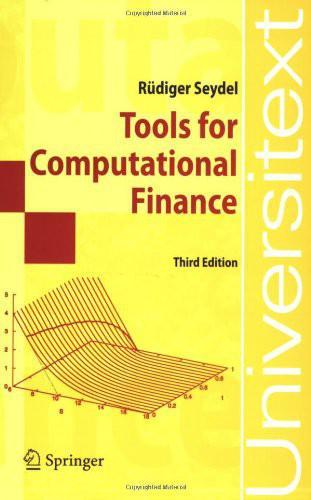
Tools for Computational Finance
by
Rüdiger Seydel
Published 2 Jan 2002
Accordingly the Itô integral of f is defined as t t f (s)dWs := l.i.m.n→∞ bn (s)dWs , t0 t0 for simple processes bn defined by (1.30). The value of the integral is independent of the choice of the bn in (1.30). The Itô integral as function in t is a stochastic process with the martingale property. If an integrand a(x, t) depends on a stochastic process Xt , the function f is given by f (t) = a(Xt , t). For the simplest case of a constant integrand a(Xt , t) = a0 the Itô integral can be reduced via (1.29) to t dWs = Wt − Wt0 . t0 For the “first” nontrivial Itô integral consider Xt = Wt and a(Wt , t) = Wt .
…
Generally for 0 ≤ s < t the property Wt −Ws ∼ N (0, t−s) holds, in particular E(Wt − Ws ) = 0 , Var(Wt − Ws ) = E((Wt − Ws )2 ) = t − s. (1.21a) (1.21b) The relations (1.21a,b) can be derived from Definition 1.7 (−→ Exercise 1.9). The relation (1.21b) is also known as 1.6 Stochastic Processes E((∆Wt )2 ) = ∆t . 27 (1.21c) The independence of the increments according to Definition 1.7(c) implies for tj+1 > tj the independence of Wtj and (Wtj+1 − Wtj ), but not of Wtj+1 and (Wtj+1 − Wtj ). Wiener processes are examples of martingales — there is no drift. Discrete-Time Model Let ∆t > 0 be a constant time increment. For the discrete instances tj := j∆t the value Wt can be written as a sum of increments ∆Wk , j Wj∆t = k=1 Wk∆t − W(k−1)∆t .
…
For references on risk-neutral valuation we mention [Hull00], [MR97], [Kwok98] and [Shr04]. on Section 1.6: Introductions into stochastic processes and further hints on advanced literature may be found in [Doob53], [Fr71], [Ar74], [Bi79], [RY91], [KP92], [Shi99], [Sato99]. The requirement (a) of Definition 1.7 (W0 = 0) is merely a convention of technical relevance; it serves as normalization. This Brownian motion ist called standard Brownian motion. For a proof of the nondifferentiability of Wiener processes, see [HuK00]. For more hints on martingales, see Appendix B2. In contrast to the results for Wiener processes, differentiable functions Wt satisfy for δN → 0 (Wtj − Wtj−1 )2 −→ 0 .
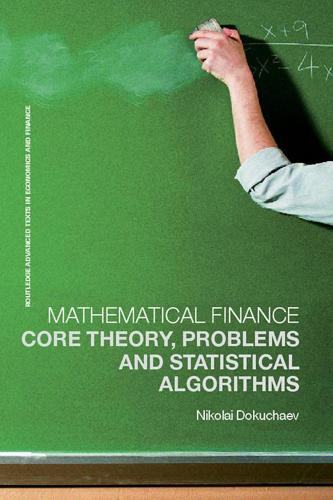
Mathematical Finance: Core Theory, Problems and Statistical Algorithms
by
Nikolai Dokuchaev
Published 24 Apr 2007
We consider a random direct line L in R such that with probability 1, and that the angle between L and the vector (1, 0) has the uniform distribution on [0, π). Find the probability that the set © 2007 Nikolai Dokuchaev is finite. 2 Basics of stochastic processes In this chapter, some basic facts and definitions from the theory of stochastic (random) processes are given, including filtrations, martingales, Markov times, and Markov processes. 2.1 Definitions of stochastic processes Sometimes it is necessary to consider random variables or vectors that depend on time. Definition 2.1 A sequence of random variables ξt, t=0, 1, 2,…, is said to be a discrete time stochastic (or random) process. be given.
…
Then the process ηt is said to be a random walk. The theory of stochastic processes studies their pathwise properties (or properties of trajectories ξ(t, ω) for given ω, as well as the evolution of the probability distributions. © 2007 Nikolai Dokuchaev Mathematical Finance 18 Definition 2.7 A continuous time process ξ(t)=ξ(t, ω) is said to be continuous (or pathwise continuous), if trajectories ξ(t, ω) are continuous in t a.s. (i.e., with probability 1, or for a.e. ω). It can happen that a continuous time process is not continuous (for instance, a process with jumps). 2.2 Filtrations, independent processes and martingales In this section, we shall assume that either or t=0, 1, 2,….
…
., the sequence (Note that is not ‘non-decreasing’), therefore to make the sequence non-decreasing, we must replace is not a filtration; by Independent processes Definition 2.13 Random processes ξ(·) and η(·) are said to be independent iff the events and are independent for all m,n, and all times (t1,…, tn) and (τ1,…, τm), and all sets In fact, processes are independent iff all events from the filtrations generated by them are mutually independent. Martingales Definition 2.14 Let ξ(t) be a process such that E|ξ(t)|2<+∞ for all t, and let if filtration. We say that ξ(t) is a martingale with respect to be a Note that we require that E|ξ(t)|2<+∞ because, for simplicity, we have defined the conditional expectation only for this case. In the literature, the martingales are often defined under the condition E|ξ(t)|<+∞, which is less restrictive. Sometimes the term ‘martingale’ is used without mentioning the filtration. Definition 2.15 Let ξ(t) be a process, and let be the filtration generated by this process.
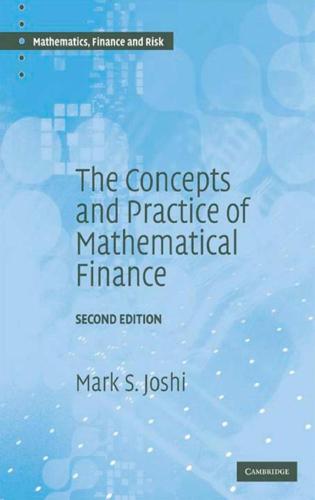
The Concepts and Practice of Mathematical Finance
by
Mark S. Joshi
Published 24 Dec 2003
Kogan, Pricing American Options: A Duality Approach, Operations Research 52(2), 2004, 258-270. References 529 [68] J.M. Harrison, D.M. Kreps, Martingales and arbitrage in multi-period securities markets, Journal of Economic Theory 20, 1979, 381-408. [69] J.M. Harrison, S.R. Pliska, Martingales and stochastic integration in the theory of continuous trading, Stochastic Processes and Applications 11, 1981, 215-60. [70] J.M. Harrison, S.R. Pliska, Martingales and stochastic integration in the theory of continuous trading, Stochastic Processes and Applications 13, 1983, 313-16. [71] D. Heath, R. Jarrow, A. Morton, Bond pricing and the term structure of interest rates: a new methodology for contingent claims valuation, Econometrica 60, 1992, 77-105. [72] S.
…
We return to multiple time horizons and view stochastic processes as the slow revelation of a single path drawn in advance. The concept of information is examined in this context, and defined using filtrations. In the discrete setting, we define expectations conditioned on information. A martingale is defined to be a process such that its value is always equal to its expected value. It is shown that martingale pricing implies absence of arbitrage in the discrete setting. The basic properties of conditioning on information are surveyed in the continuous setting. Continuous martingales are identified to be processes with zero drift (up to technical conditions.)
…
Exercise 6.20 Find the Black-Scholes price of an option paying (ST - K)+ at time T. 180 Risk neutrality and martingale measures Exercise 6.21 Find the Black-Scholes price of an option paying (K - ST)+ at time T. Exercise 6.22 Let Wt be a Brownian motion, and let Ft be its filtration. Compute the following when t > s: lE(Wt 1 mss); E(Wr IY'); ]E(W41y). What happens if s < t? Exercise 6.23 A derivative pays (log ST)3 at time T. Develop a price in the BlackScholes world. Exercise 6.24 If Wt is a Brownian motion, is Wt a martingale? Justify your answer. Exercise 6.25 Give an example of a continuous time stochastic process, Xt, such that IE(Xt) = 0, and X t is not a martingale. Exercise 6.26 If S and B follow Black-Scholes assumptions, what is the drift of S in the martingale measure associated to taking S + B as numeraire?
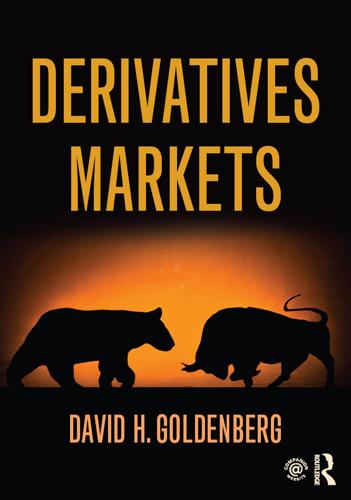
Derivatives Markets
by
David Goldenberg
Published 2 Mar 2016
A discrete-time stochastic process (Xn(ω))n=0,1,2,3,… is called a sub-martingale if E(Xn)<∞, and E(Xn+1(ω)|Xn)>Xn for all n=0,1,2,3,… 2. A discrete-time stochastic process (Xn(ω))n=0,1,2,3,… is called a super-martingale if E(Xn)<∞, , and E(Xn+1(ω)|Xn)<Xn for all n=0,1,2,3,… We expect stock prices to be sub-martingales, not martingales, for two separate and different reasons: 1. All assets, risky or not, have to provide a reward for time and waiting. This reward is the risk-free rate. 2. Risky assets have to also reward investors for non-diversifiable risks. 15.4.1 The Equivalent Martingale Representation of Stock Prices Not all hope is lost for the martingale representation of stock prices under risk neutrality.
…
We now have two results, E(W1(ω)|W0)=W0 and, E(W2(ω)|W1)=W1. 15.3.2 Definition of a Discrete-Time Martingale A discrete-time stochastic process (Xn(ω))n=0,1,2,3,.. is called a martingale if, 1. E(Xn)<∞ and for all n and, 2. E(Xn+1(ω)|Xn)=Xn for all n=0,1,2,3,… Note that our martingales have finite first and second moments. As we have seen in example 2, martingales are constructed from independent fair games. If we add independent fair games to a given starting wealth process, we will end up with a wealth process that is a martingale. Conversely, if the wealth process is a martingale with finite means and variances, then it must have been generated in this way, by adding uncorrelated fair games to an initial wealth process and proceeding in this way.
…
Chapter 16 begins this program. 15.7 APPENDIX: ESSENTIAL MARTINGALE PROPERTIES Here we collect a few of the many properties of martingales that are used in proving results that make martingales useful in applied finance. We restrict attention to discrete-time martingales and sometimes even choose N=2. No attempt at mathematical rigor is claimed. The intuition behind these results is the primary concern. We start with a discrete-time stochastic process (Xn(ω)n=0,1,2,3,… with finite first and second moments E(Xn)<∞ and for all n=0,1,2,3,… and the martingale property, 1. Tower Property (TP) This is a general property of conditional expectations and doesn’t require a martingale. The Tower Property says that, whenever we condition a martingale process by an event earlier than the immediately preceding one, like X0, we can break this down into a two-step process.
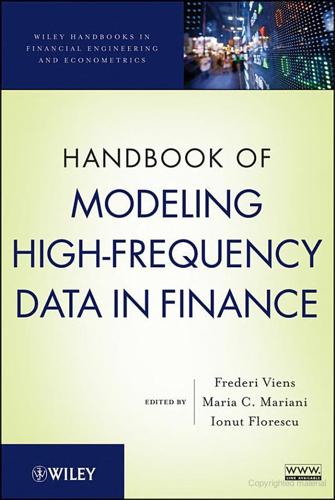
Handbook of Modeling High-Frequency Data in Finance
by
Frederi G. Viens
,
Maria C. Mariani
and
Ionut Florescu
Published 20 Dec 2011
A strict white noise process with mean 0 and variance σ 2 is denoted as SWN(0, σ 2 ). 178 CHAPTER 7 Risk Forecasting with Multiple Timescales DEFINITION 7.15 Martingale Difference (Xt )t∈Z is a martingale-difference sequence with respect to the filtration {Ft }t∈Z if E|Xt | < ∞, Xt is Ft measurable and E(Xt |Ft−1 ) = 0, ∀t ∈ Z. The unconditional mean of such a process is also zero: E(Xt ) = E(E(Xt |Ft−1 )) = 0. Moreover, if E(Xt2 ) < ∞, then autocovariances satisfy E(E(Xt Xs |Fs−1 )) = E(Xt E(Xs |Fs−1 )) = 0, E(Xt Xs ) = E(E(Xt Xs |Ft−1 )) = E(Xs E(Xt |Ft−1 )) = 0, t < s, t > s. (7.42) Thus a finite-variance martingale-difference process has zero mean and zero covariance. If the variance is constant for all t, the process is covariance stationary.
…
., xiv, 347, 383 Market capitalization index, 128 Market completeness assumption, 302 Market complexity, modeling of, 99 Market crash, 346 2008, 136 Market index (indices) exponents calculated for, 345 squared returns of, 220 technique for producing, 110 Market index decrease, spread and, 105 Market inefficiencies, for small-space and mid-volume classes, 44 Market microstructure effects, 263 Market microstructure, effects on Fourier estimator, 245 Market microstructure contaminations, 273 Market microstructure model, of ultra high frequency trading, 235–242 Market model, 296–297 Market movement, indicators of, 110 Market reaction, to abnormal price movements, 45 Market-traded option prices, 219 Markov chain, stochastic volatility process with, 401 Markowitz-type optimization, 286 Martingale-difference process, 178. See also Continuous semimartingales; Equivalent martingale measure; Exponential martingale process Supermartingale Matlab, 14, 257 Matlab module, 125, 339 Maximum likelihood estimation (MLE), 13–14, 185 Index finite-sample performance of, 14–17 performance of, 23–24 Maximum likelihood estimators (MLEs, mles), 4, 6, 172–175, 190, 225.
…
New York: Chapman and Hall; 1994. 6. Levy P. Calcul des probabilités. Paris: Gauthier-Villars; 1925. 7. Khintchine AYa, Levy P. Sur les lois stables. C R Acad Sci Paris;1936;202:374. 8. Mantegna RN, Stanley HE. Stochastic process with ultra-slow convergence to a Gaussian: the truncated Levy flight. Phys Rev Lett;1994;73:2946– 2949. 9. Koponen I. Analytic approach to the problem of convergence of truncated Levy flights towards the Gaussian stochastic process. Phys Rev E;1995;52:1197–1199. 10. Weron R. Levy-stable distributions revisited: tail index> 2 does not exclude the Levy-stable regime. Int J Mod Phys C; 2001;12:209–223. Chapter Thirteen Solutions to Integro-Differential Parabolic Problem Arising on Financial Mathematics MARIA C.

Frequently Asked Questions in Quantitative Finance
by
Paul Wilmott
Published 3 Jan 2007
Wilmott magazine, September Halton, JH 1960 On the efficiency of certain quasi-random sequences of points in evaluating multi-dimensional integrals. Num. Maths. 2 84-90 Hammersley, JM & Handscomb, DC 1964 Monte Carlo Methods. Methuen, London Harrison, JM & Kreps, D 1979 Martingales and arbitrage in multiperiod securities markets. Journal of Economic Theory 20 381-408 Harrison, JM & Pliska, SR 1981 Martingales and stochastic integrals in the theory of continuous trading. Stochastic Processes and their Applications 11 215-260 Haselgrove, CB 1961 A method for numerical integration. Mathematics of Computation 15 323-337 Heath, D, Jarrow, R & Morton, A 1992 Bond pricing and the term structure of interest rates: a new methodology.
…
Journal of Political Economy 81 637-59 Cox, J & Rubinstein, M 1985 Options Markets. Prentice-Hall Derman, E & Kani, I 1994 Riding on a smile. Risk magazine 7 (2) 32-39 Dupire, B 1994 Pricing with a smile. Risk magazine 7 (1) 18-20 Harrison, JM & Kreps, D 1979 Martingales and arbitrage in multiperiod securities markets. Journal of Economic Theory 20 381-408 Harrison, JM & Pliska, SR 1981 Martingales and stochastic integrals in the theory of continuous trading. Stochastic Processes and their Applications 11 215-260 Joshi, M 2003 The Concepts and Practice of Mathematical Finance. CUP Rubinstein, M 1976 The valuation of uncertain income streams and the pricing of options.
…
Therefore a price is non-arbitrageable in the real world if and only if it is non-arbitrageable in the risk-neutral world. The risk-neutral price is always non-arbitrageable. If everything has a discounted asset price process which is a martingale then there can be no arbitrage. So if we change to a measure in which all the fundamental assets, for example the stock and bond, are martingales after discounting, and then define the option price to be the discounted expectation making it into a martingale too, we have that everything is a martingale in the risk-neutral world. Therefore there is no arbitrage in the real world. Explanation 4: If we have calls with a continuous distribution of strikes from zero to infinity then we can synthesize arbitrarily well any payoff with the same expiration.

Mathematics of the Financial Markets: Financial Instruments and Derivatives Modelling, Valuation and Risk Issues
by
Alain Ruttiens
Published 24 Apr 2013
Sections 7.1 and 7.2), neither does S(T) depend on earlier values of S at previous times t. With this respect, the geometric Wiener process under Q, of Eq. 8.16, using the risk neutral probability measure, is called a semimartingale, That is, a variant of a “martingale”. A martingale is a Markovian (memory-less) stochastic process such as, at t, the conditional expected value of St+1 is St. In our case, we talk of a semimartingale, that is, a martingale completed by a finite variation, of the ert form here. Indeed, in our case, E(St + 1|St, …, S1) does not equal St, but the forward value Ft + 1Q = St er(t + 1). These notions will play a major role in the option pricing theory, see Chapter 10, in particular Section 10.2.4.
…
Contents Cover Series Title Page Copyright Dedication Foreword Main Notations Introduction Part I: The Deterministic Environment Chapter 1: Prior to the yield curve: spot and forward rates 1.1 INTEREST RATES, PRESENT AND FUTURE VALUES, INTEREST COMPOUNDING 1.2 DISCOUNT FACTORS 1.3 CONTINUOUS COMPOUNDING AND CONTINUOUS RATES 1.4 FORWARD RATES 1.5 THE NO ARBITRAGE CONDITION FURTHER READING Chapter 2: The term structure or yield curve 2.1 INTRODUCTION TO THE YIELD CURVE 2.2 THE YIELD CURVE COMPONENTS 2.3 BUILDING A YIELD CURVE: METHODOLOGY 2.4 AN EXAMPLE OF YIELD CURVE POINTS DETERMINATION 2.5 INTERPOLATIONS ON A YIELD CURVE FURTHER READING Chapter 3: Spot instruments 3.1 SHORT-TERM RATES 3.2 BONDS 3.3 CURRENCIES FURTHER READING Chapter 4: Equities and stock indexes 4.1 STOCKS VALUATION 4.2 STOCK INDEXES 4.3 THE PORTFOLIO THEORY FURTHER READING Chapter 5: Forward instruments 5.1 THE FORWARD FOREIGN EXCHANGE 5.2 FRAs 5.3 OTHER FORWARD CONTRACTS 5.4 CONTRACTS FOR DIFFERENCE (CFD) FURTHER READING Chapter 6: Swaps 6.1 DEFINITIONS AND FIRST EXAMPLES 6.2 PRIOR TO AN IRS SWAP PRICING METHOD 6.3 PRICING OF AN IRS SWAP 6.4 (RE)VALUATION OF AN IRS SWAP 6.5 THE SWAP (RATES) MARKET 6.6 PRICING OF A CRS SWAP 6.7 PRICING OF SECOND-GENERATION SWAPS FURTHER READING Chapter 7: Futures 7.1 INTRODUCTION TO FUTURES 7.2 FUTURES PRICING 7.3 FUTURES ON EQUITIES AND STOCK INDEXES 7.4 FUTURES ON SHORT-TERM INTEREST RATES 7.5 FUTURES ON BONDS 7.6 FUTURES ON CURRENCIES 7.7 FUTURES ON (NON-FINANCIAL) COMMODITIES FURTHER READING Part II: The Probabilistic Environment Chapter 8: The basis of stochastic calculus 8.1 STOCHASTIC PROCESSES 8.2 THE STANDARD WIENER PROCESS, OR BROWNIAN MOTION 8.3 THE GENERAL WIENER PROCESS 8.4 THE ITÔ PROCESS 8.5 APPLICATION OF THE GENERAL WIENER PROCESS 8.6 THE ITÔ LEMMA 8.7 APPLICATION OF THE ITô LEMMA 8.8 NOTION OF RISK NEUTRAL PROBABILITY 8.9 NOTION OF MARTINGALE ANNEX 8.1: PROOFS OF THE PROPERTIES OF dZ(t) ANNEX 8.2: PROOF OF THE ITÔ LEMMA FURTHER READING Chapter 9: Other financial models: from ARMA to the GARCH family 9.1 THE AUTOREGRESSIVE (AR) PROCESS 9.2 THE MOVING AVERAGE (MA) PROCESS 9.3 THE AUTOREGRESSION MOVING AVERAGE (ARMA) PROCESS 9.4 THE AUTOREGRESSIVE INTEGRATED MOVING AVERAGE (ARIMA) PROCESS 9.5 THE ARCH PROCESS 9.6 THE GARCH PROCESS 9.7 VARIANTS OF (G)ARCH PROCESSES 9.8 THE MIDAS PROCESS FURTHER READING Chapter 10: Option pricing in general 10.1 INTRODUCTION TO OPTION PRICING 10.2 THE BLACK–SCHOLES FORMULA 10.3 FINITE DIFFERENCE METHODS: THE COX–ROSS–RUBINSTEIN (CRR) OPTION PRICING MODEL 10.4 MONTE CARLO SIMULATIONS 10.5 OPTION PRICING SENSITIVITIES FURTHER READING Chapter 11: Options on specific underlyings and exotic options 11.1 CURRENCY OPTIONS 11.2 OPTIONS ON BONDS 11.3 OPTIONS ON INTEREST RATES 11.4 EXCHANGE OPTIONS 11.5 BASKET OPTIONS 11.6 BERMUDAN OPTIONS 11.7 OPTIONS ON NON-FINANCIAL UNDERLYINGS 11.8 SECOND-GENERATION OPTIONS, OR EXOTICS FURTHER READING Chapter 12: Volatility and volatility derivatives 12.1 PRACTICAL ISSUES ABOUT THE VOLATILITY 12.2 MODELING THE VOLATILITY 12.3 REALIZED VOLATILITY MODELS 12.4 MODELING THE CORRELATION 12.5 VOLATILITY AND VARIANCE SWAPS FURTHER READING Chapter 13: Credit derivatives 13.1 INTRODUCTION TO CREDIT DERIVATIVES 13.2 VALUATION OF CREDIT DERIVATIVES 13.3 CONCLUSION FURTHER READING Chapter 14: Market performance and risk measures 14.1 RETURN AND RISK MEASURES 14.2 VaR OR VALUE-AT-RISK FURTHER READING Chapter 15: Beyond the Gaussian hypothesis: potential troubles with derivatives valuation 15.1 ALTERNATIVES TO THE GAUSSIAN HYPOTHESIS 15.2 POTENTIAL TROUBLES WITH DERIVATIVES VALUATION FURTHER READING Bibliography Index For other titles in the Wiley Finance series please see www.wiley.com/finance This edition first published 2013 Copyright © 2013 Alain Ruttiens Registered office John Wiley & Sons Ltd, The Atrium, Southern Gate, Chichester, West Sussex, PO19 8SQ, United Kingdom For details of our global editorial offices, for customer services and for information about how to apply for permission to reuse the copyright material in this book please see our website at www.wiley.com.
…
short-term rates discount basis trading futures rate basis trading spot instruments skewness smiles, volatility smirks, volatility SML see security market line Sortino ratio sovereign bonds Spearman’s rank correlation coefficient special purpose vehicles (SPVs) specific risk speed sensitivity splines spot instruments bonds correlation modeling currencies forex swaps Gaussian hypothesis alternatives prices rates short-term rates volatility spreads SPVs see special purpose vehicles standardized futures contracts standard Wiener process see also dZ; general Wiener process stationarity stationary Markovian processes stochastic processes basis of Brownian motion definition of process diffusion processes discrete/continuous variables general Wiener process Markovian processes martingales probability reminders risk neutral probability standard Wiener process stationary/non-stationary processes terminology stock indexes basket options futures stock portfolios stock prices stock valuation book value method DCF method Gordon–Shapiro method real option method stocks without dividends stress tests Structural model Student distribution swaps bond duration conditional CRSs curves forwards ISDA second-generation swap points swap rate markets variance volatility see also forex swaps; interest rate swaps swaptions systematic factors Taiwan dollars (TWD) Taleb, Nassim Taylor series TE see Tracking Error term structure theoretical price forward foreign exchange futures theta time, continuous/discrete time horizon, VaR time value of option time-weighted rate of return (TWRR) Tiscali telecommunications Total total period, FRAs Toy see Black, Derman, Toy process Tracking Error (TE) tranches transfer functions Treasury bonds Treynor ratio trinomial trees TWD see Taiwan dollars TWRR see time-weighted rate of return Uhlenbeck see Ohrstein–Uhlenbeck unexpected credit loss United States dollars (USD) CRS swaps forward foreign exchange futures NDOs swap rates market volatility unwinding swaps USD see United States dollars valuation callable bonds credit derivatives IRSs stocks troubles value-at-risk (VaR) backtesting correlation troubles example important remarks methods parameters variants value-weighted indexes vanilla IRSs vanilla options vanilla swaps CRSs in-arrear swaps IRSs vanna VaR see value-at-risk variance-covariance method, VaR “variance gamma” process variance swaps Vasicek model VDAX index vega VIX index volatility annualized basket options correlation modeling curves delta-gamma neutral management derivatives dVega/dTime general Wiener process historical implied intraday volatility modeling option pricing practical issues realized models smiles smirks variance swaps vega volga vomma VXN index weather White see Hull and White model white noise AR process see also Brownian motion; standard Wiener process Wiener see general Wiener process; standard Wiener process WTI Crude Oil futures Yang–Zang volatility yield, convenience yield curves capital markets components CRS pricing cubic splines method definition EONIA/OIS swaps implied volatility interest rate options interpolations linear method methodology money markets points determination example polynomial curve methods swap curve swaps see also term structure yield to maturity (YTM) Z see dZ Zang see Yang–Zang volatility zero-coupon bonds zero-coupon rates see also spot instruments, rates zero-coupon swaps Z-score
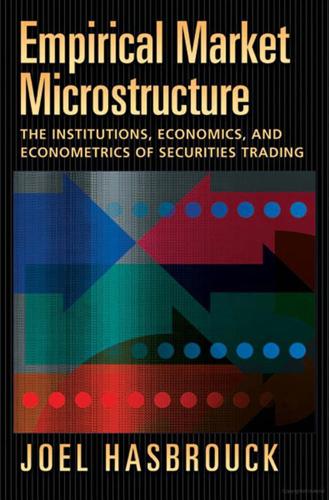
Empirical Market Microstructure: The Institutions, Economics and Econometrics of Securities Trading
by
Joel Hasbrouck
Published 4 Jan 2007
A process with this property is generally described as a martingale. One definition of a martingale is a discrete stochastic process {xt } where E|xt | < ∞ for all t, and E(xt+1 | xt , xt−1 , . . . ) = xt (see Karlin and Taylor (1975) or Ross (1996)). Martingale behavior of asset prices is a classic result arising in many economic models with individual optimization, absence of arbitrage, or security market equilibrium (Cochrane (2005)). The result is generally contingent, however, on assumptions of frictionless trading opportunities, which are not appropriate in most microstructure applications. The martingale nevertheless retains a prominent role.
…
In microstructure analyses, transaction prices are usually not martingales. Sometimes it is not even the case that the public information includes the history of transaction prices. (In dealer markets, trades are often not reported.) By imposing economic or statistical structure, though, it is often possible to identify a martingale component of the price (with respect to a particular information set). Later chapters will indicate how this can be accomplished. A random-walk is a process constructed as the sum of independently and identically distributed (i.i.d.) zero-mean random variables (Ross (1996), p. 328). It is a special case of a martingale. The price in Equation 3.1, for example, cumulates the ut .
…
The process {xt } is a martingale with respect to another (possibly multidimensional) process {zt } if E|xt | < ∞ for all t and E(xt+1 | zt , zt−1 , . . .) = xt (Karlin and Taylor (1975), definition 1.2, p. 241). In particular, suppose that at some terminal time the cash value or payoff of a security is a random variable v . Traders form a sequence of beliefs based on a sequence of information sets 1 , 2 , . . . This sequence does not contract: Something known at time t is known at time τ > t. Then the conditional expectation 25 26 EMPIRICAL MARKET MICROSTRUCTURE xt = E[v |t ] is a martingale with respect to the sequence of information sets {k }.
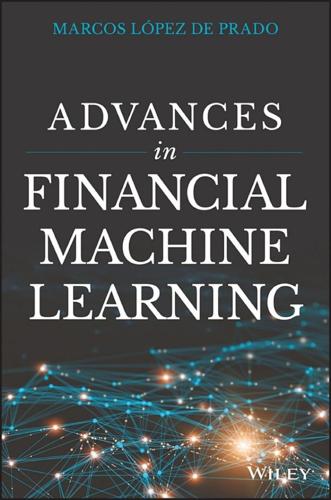
Advances in Financial Machine Learning
by
Marcos Lopez de Prado
Published 2 Feb 2018
After Hosking's paper, the literature on this subject has been surprisingly scarce, adding up to eight journal articles written by only nine authors: Hosking, Johansen, Nielsen, MacKinnon, Jensen, Jones, Popiel, Cavaliere, and Taylor. See the references for details. Most of those papers relate to technical matters, such as fast algorithms for the calculation of fractional differentiation in continuous stochastic processes (e.g., Jensen and Nielsen [2014]). Differentiating the stochastic process is a computationally expensive operation. In this chapter we will take a practical, alternative, and novel approach to recover stationarity: We will generalize the difference operator to non-integer steps. 5.4 The Method Consider the backshift operator, B, applied to a matrix of real-valued features {Xt}, where BkXt = Xt − k for any integer k ≥ 0.
…
While assessing the probability of backtest overfitting is a useful tool to discard superfluous investment strategies, it would be better to avoid the risk of overfitting, at least in the context of calibrating a trading rule. In theory this could be accomplished by deriving the optimal parameters for the trading rule directly from the stochastic process that generates the data, rather than engaging in historical simulations. This is the approach we take in this chapter. Using the entire historical sample, we will characterize the stochastic process that generates the observed stream of returns, and derive the optimal values for the trading rule's parameters without requiring a historical simulation. 13.3 The Problem Suppose an investment strategy S invests in i = 1, …I opportunities or bets.
…
Snippet 17.2 Preparing the datasets Snippet 17.3 lists function lagDF, which applies to a dataframe the lags specified in its argument lags. Snippet 17.3 Apply Lags to Dataframe Finally, Snippet 17.4 lists function getBetas, which carries out the actual regressions. Snippet 17.4 Fitting the ADF specification 17.4.3 Sub- and Super-Martingale Tests In this section we will introduce explosiveness tests that do not rely on the standard ADF specification. Consider a process that is either a sub- or super-martingale. Given some observations {yt}, we would like to test for the existence of an explosive time trend, H0: β = 0, H1: β ≠ 0, under alternative specifications: Polynomial trend (SM-Poly1): Polynomial trend (SM-Poly2): Exponential trend (SM-Exp): Power trend (SM-Power): Similar to SADF, we fit any of these specifications to each end point t = τ, …, T, with backwards expanding start points, then compute The reason for the absolute value is that we are equally interested in explosive growth and collapse.
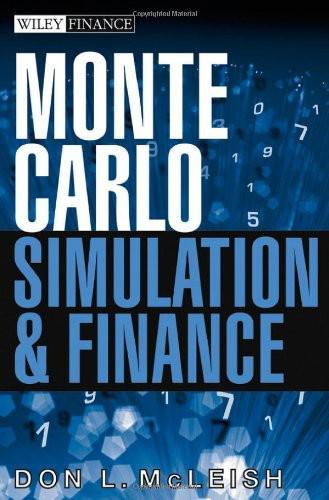
Monte Carlo Simulation and Finance
by
Don L. McLeish
Published 1 Apr 2005
For a more formal definition, as well as an explanation of how we should interpret the integral, see the appendix. This process Zs is, both in discrete and continuous time, a martingale. MODELS IN CONTINUOUS TIME 67 Wiener Process 3 2.5 2 W(t) 1.5 1 0.5 0 -0.5 -1 0 1 2 3 4 5 t 6 7 8 9 Figure 2.6: A sample path of the Wiener process Models in Continuous Time We begin with some oversimplified rules of stochastic calculus which can be omitted by those with a background in Brownian motion and diffusion. First, we define a stochastic process Wt called the standard Brownian motion or Wiener process having the following properties; 1. For each h > 0, the increment W (t+h)−W (t) has a N (0, h) distribution and is independent of all preceding increments W (u) − W (v), t > u > v > 0. 2.
…
This equation (2.6) describes an elegant mathematical property shared by all marketable securities in a complete market. Under the risk-neutral measure, the discounted price Yt = St /Bt forms a martingale. A martingale is a process Yt for which the expectation of a future value given the present is equal to the present i.e. E(Yt+1 |Ht ) = Yt .for all t. (2.7) Properties of a martingale are given in the appendix and it is easy to show that for such a process, when T > t, E(YT |Ht ) = E[...E[E(YT |HT −1 )|HT −2 ]...|Ht ] = Yt . (2.8) A martingale is a fair game in a world with no inflation, no need to consume and no mortality. Your future fortune if you play the game is a random variable whose expectation, given everything you know at present, is your present fortune.
…
Your future fortune if you play the game is a random variable whose expectation, given everything you know at present, is your present fortune. Thus, under a risk-neutral measure Q in a complete market, all marketable securities discounted to the present form martingales. For this reason, we often refer to the risk-neutral measure as a martingale measure. The fact that prices of 24 CHAPTER 2. SOME BASIC THEORY OF FINANCE marketable commodities must be martingales under the risk neutral measure has many consequences for the canny investor. Suppose, for example, you believe that you are able to model the history of the price process nearly perfectly, and it tells you that the price of a share of XXX computer systems increases on average 20% per year.
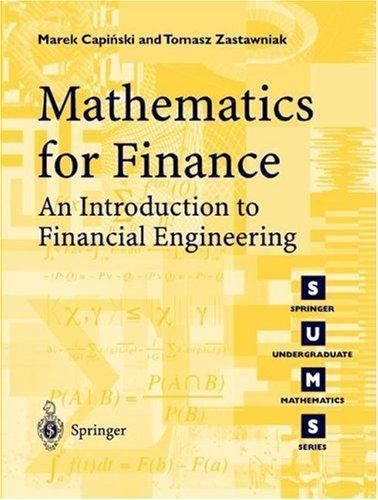
Mathematics for Finance: An Introduction to Financial Engineering
by
Marek Capinski
and
Tomasz Zastawniak
Published 6 Jul 2003
Definition 4.5 A sequence of random variables X(0), X(1), X(2), . . . such that E∗ (X(n + 1)|S(n)) = X(n) for each n = 0, 1, 2, . . . is said to be a martingale with respect to P∗ . Condition (4.3) can be expressed by saying that the discounted stock prices Sj (0), Sj (1), Sj (2), . . . form a martingale with respect to P∗ . The latter is called a risk-neutral or martingale probability on the set of scenarios Ω. Moreover, E∗ is called a risk-neutral or martingale expectation. 84 Mathematics for Finance Example 4.5 Let A(0) = 100, A(1) = 110, A(2) = 121 and suppose that stock prices can follow four possible scenarios: Scenario ω1 ω2 ω3 ω4 S(0) 90 90 90 90 S(1) 100 100 80 80 S(2) 112 106 90 80 The tree of stock prices is shown in Figure 4.2.
…
Dividing both sides of the equality in Proposition 3.5 by (1 + r)n+1 , we obtain the following important result for the discounted stock prices S(n) = −n S(n) (1 + r) . Corollary 3.6 (Martingale Property) For any n = 0, 1, 2, . . . E∗ (S(n + 1)|S(n)) = S(n). We say that the discounted stock prices S(n) form a martingale under the risk-neutral probability p∗ . The probability p∗ itself is also referred to as the martingale probability. Exercise 3.19 Let r = 0.2. Find the risk-neutral conditional expectation of S(3) given that S(2) = 110 dollars. 3.3 Other Models This section may be skipped at first reading because the main ideas to follow later do not depend on the models presented here. 64 Mathematics for Finance 3.3.1 Trinomial Tree Model A natural generalisation of the binomial tree model extends the range of possible values of the one-step returns K(n) to three.
…
The prices C E (0) and C E (1) can be found using the Fundamental Theorem of Asset Pricing. (Which explains the name of the theorem!) According to the theorem, there is a probability P∗ such that the discounted stock and option prices S(n) = S(n)/A(n) and C E (n) = C E (n)/A(n) are martingales, or else an arbitrage opportunity would exist. However, there is only one probability P∗ turning S(n) into a martingale, namely that found in Example 4.5. As a result, C E (n) must be a martingale with respect to the same probability P∗ . This gives C E (1) = A(1) E∗ (C E (2)|S(1)) A(2) and C E (0) = A(0) E∗ (C E (1)). A(1) The values of P∗ for each scenario found in Example 4.5 can now be used to compute C E (1) and then C E (0).
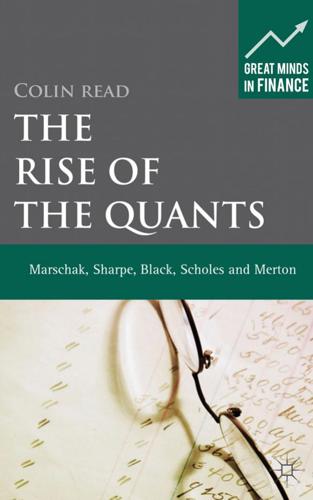
The Rise of the Quants: Marschak, Sharpe, Black, Scholes and Merton
by
Colin Read
Published 16 Jul 2012
Life cycle – the characterization of a process from its birth to death. Life Cycle Model – a model of household consumption behavior from the beginning of its earning capacity to the end of the household. Markov process – a stochastic process with the memorylessness property for which the present state, future state, and past observations are independent. Markowitz bullet – the upper boundary of the efficient frontier of various portfolios when graphed according to risk and return. Martingale – a model of a process for which past events cannot predict future outcomes. Mean – a mathematical technique that can be calculated based on a number of alternative weightings to produce an average for a set of numbers.
…
While he had demonstrated that an options price depends on the underlying stock price mean and volatility, and the risk-free interest rate, the overall market for interest rates is much more multi-dimensional. The interest rate yield curve, which graphs rates against maturities, depends on many markets and instruments, each of which is subject to stochastic processes. His interest and collaboration with Emanuel Derman and Bill Toy resulted in a model of interest rates that was first used profitably by Goldman Sachs through the 1980s, but eventually entered the public domain when they published their work in the Financial Analysts Journal in 1990.2 Their model provided reasonable estimates for both the prices and volatilities of treasury bonds, and is still used today.
…
Black-Scholes model – a model that can determine the price of a European call option based on the assumption that the underlying security follows a geometric Brownian motion with constant drift and volatility. Bond – a financial instrument that provides periodic (typically semi-annual) interest payments and the return of the paid-in capital upon maturity in exchange for a fixed price. Brownian motion – the simplest of the class of continuous-time stochastic processes that describes the random motion of a particle or a security that is buffeted by forces that are normally distributed in strength. Calculus of variations – a mathematical technique that can determine the optimal path of a variable, like savings or consumption, over time. Call – an option to purchase a specified security at a specified future time and price.

Analysis of Financial Time Series
by
Ruey S. Tsay
Published 14 Oct 2001
ISBN: 0-471-41544-8 CHAPTER 6 Continuous-Time Models and Their Applications Price of a financial asset evolves over time and forms a stochastic process, which is a statistical term used to describe the evolution of a random variable over time. The observed prices are a realization of the underlying stochastic process. The theory of stochastic process is the basis on which the observed prices are analyzed and statistical inference is made. There are two types of stochastic process for modeling the price of an asset. The first type is called the discrete-time stochastic process, in which the price changes at discrete time points. All the processes discussed in the previous chapters belong to this category.
…
For the price of an asset at time t, the range of x(η, t) is the set of non-negative real numbers. For a given η, {x(η, t)} is a time series with values depending on the time t. For simplicity, we 223 STOCHASTIC PROCESSES write a continuous-time stochastic process as {xt } with the understanding that, for a given t, xt is a random variable. In the literature, some authors use x(t) instead of xt to emphasize that t is continuous. However, we use the same notation xt , but call it a continuous-time stochastic process. 6.2.1 The Wiener Process In a discrete-time econometric model, we assume that the shocks form a white noise process, which is not predictable.
…
This is the purpose of discussing Ito’s calculus in the next section. 6.2.2 Generalized Wiener Processes The Wiener process is a special stochastic process with zero drift and variance proportional to the length of time interval. This means that the rate of change in expectation is zero and the rate of change in variance is 1. In practice, the mean and variance of a stochastic process can evolve over time in a more complicated manner. Hence, further generalization of stochastic process is needed. To this end, we consider the generalized Wiener process in which the expectation has a drift rate µ and the rate of variance change is σ 2 .
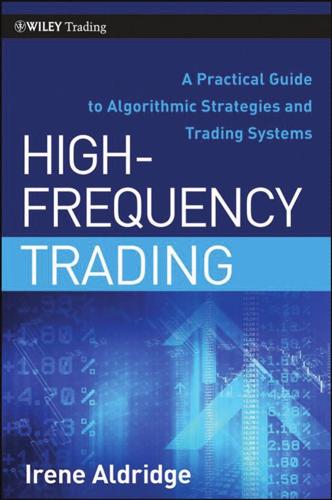
High-Frequency Trading: A Practical Guide to Algorithmic Strategies and Trading Systems
by
Irene Aldridge
Published 1 Dec 2009
Market Efficiency Tests Based on the Martingale Hypothesis A classic definition of market efficiency in terms of security returns is due to Market Inefficiency and Profit Opportunities at Different Frequencies 87 Samuelson (1965), who showed that properly anticipated prices fluctuate randomly in an efficient market. In other words, if all of the news is incorporated instantaneously into the price of a given financial security, the expected price of the security given current information is always the current price of the security itself. This relationship is known as a martingale. Formally, a stochastic price process {Pt } is a martingale within information set It if the best forecast of Pt+1 based on current information It is equal to Pt : E[Pt+1 |It ] = Pt (7.13) Applying the martingale hypothesis to changes in price levels, we can express “abnormal,” or returns in excess of expected returns given current information, as follows: Zt+1 = Pt+1 − E[Pt+1 |It ] (7.14) A market in a particular financial security or a portfolio of financial securities is then said to be efficient when abnormal return Zt+1 is a “fair game”—that is, E[Zt+1 |It ] = 0 (7.15) LeRoy (1989) provides an extensive summary of the literature on the subject.
…
Formally, a stochastic price process {Pt } is a martingale within information set It if the best forecast of Pt+1 based on current information It is equal to Pt : E[Pt+1 |It ] = Pt (7.13) Applying the martingale hypothesis to changes in price levels, we can express “abnormal,” or returns in excess of expected returns given current information, as follows: Zt+1 = Pt+1 − E[Pt+1 |It ] (7.14) A market in a particular financial security or a portfolio of financial securities is then said to be efficient when abnormal return Zt+1 is a “fair game”—that is, E[Zt+1 |It ] = 0 (7.15) LeRoy (1989) provides an extensive summary of the literature on the subject.
…
The market maker is responsible for deciding on and then setting bid and ask prices, receiving all orders, and clearing trades. The market maker’s objective is to maximize profits while avoiding bankruptcy or failure. The latter arise whenever the market maker has no inventory or cash. Both buy and sell orders arrive as independent stochastic processes. The model solution for optimal bid and ask prices lies in the estimation of the rates at which a unit of cash (e.g., a dollar or a “clip” of 10 million in FX) “arrives” to the market maker when a customer comes in to buy securities (pays money to the dealer) and “departs” the market maker when a customer comes in to sell (the dealer pays the customer).
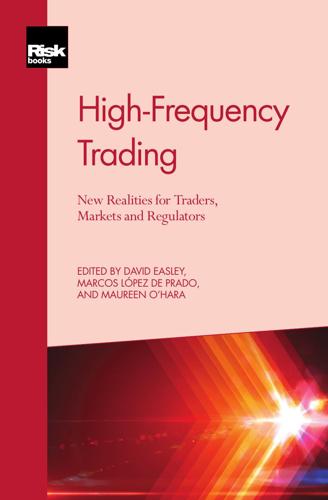
High-Frequency Trading
by
David Easley
,
Marcos López de Prado
and
Maureen O'Hara
Published 28 Sep 2013
Pedersen, 2005, “Predatory Trading”, Journal of Finance 40(4), pp. 1825–63. Carlin, B., M. Sousa Lobo and S. Viswanathan, 2007, “Episodic Liquidity Crises: Cooperative and Predatory Trading”, Journal of Finance 42(5), pp. 2235–74. Clark, P. K., 1970, “A Subordinated Stochastic Process Model of Cotton Futures Prices”, PhD Dissertation, Harvard University. Clark, P. K., 1973, “A Subordinated Stochastic Process Model with Finite Variance for Speculative Prices”, Econometrica 41(1), pp. 135–55. Donefer, B. S., 2010, “Algos Gone Wild: Risk in the World of Automated Trading Strategies”, The Journal of Trading 5, pp. 31–4. Easley, D., N. Kiefer, M.
…
We take the standard approach of assuming the efficient price is unpredictable, ie, it follows a random walk. Minus trading frictions, the efficient price at the daily or intra-day frequency can be characterised as a martingale process. Let mj be this latent price (9.7) mj = mj−1 + wt Sometimes the quote midpoint is assumed to represent this latent price. However, quote midpoints are not generally martingales with respect to all available order flow, in which case Hasbrouck (1995, p. 1179) proposes to view the random-walk component of a Stock and Watson (1988) decomposition as the “implicit efficient price”. Hasbrouck (2007, Chapters 4 and 8) constructs an efficient price more generally as the projection of mt onto all available conditioning variables, ie, the so-called filtered state estimate m̃ij = E∗ [mj | pij , pi,j−1 , . . . ] (9.8) where E∗ [·] is the linear projection of mij on a set of lagged prices.4 A standard approach to implementing such a projection is through autoregressive integrated moving average (ARIMA) time series econometrics (Hasbrouck 2007, Chapter 4).
…
O’Hara, 2012, “The Impact of Computer Trading on Liquidity, Price Efficiency/Discovery and Transactions Costs”, in Foresight: The Future of Computer Trading in Financial Markets. An International Perspective, Final Project Report. The Government Office for Science, London. Mandelbrot, B., 1973, “Comments on ‘A Subordinated Stochastic Process Model with Finite Variance for Speculative Prices by Peter K. Clark’ ”, Econometrica 41(1), pp. 157–59. Mandelbrot, B., and M. Taylor, 1967, “On the Distribution of Stock Price Differences”, Operations Research 15(6), pp. 1057–62. NANEX, 2010, “Analysis of the ‘Flash Crash’ ”, June 18. URL: http://www.nanex.net/ 20100506/FlashCrashAnalysis_CompleteText.html.
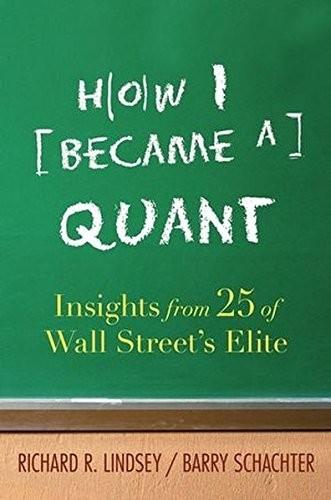
How I Became a Quant: Insights From 25 of Wall Street's Elite
by
Richard R. Lindsey
and
Barry Schachter
Published 30 Jun 2007
For starters, after years of specializing in pure mathematics, I was starting from scratch in a totally new area. It allowed me to start to learn basic mathematics instead of delving deeper and deeper into advanced subjects. I literally had to start from scratch and learn probability theory and then the basics of stochastic processes, things I knew nothing at all about. Not to mention I knew nothing about financial markets, derivatives, or JWPR007-Lindsey 122 May 7, 2007 16:55 h ow i b e cam e a quant anything at all to do with finance. It was exciting to learn so much from scratch. In the midst of reading about Black-Scholes, I was also deeply involved with writing the book with Victor Ginzburg from the University of Chicago.
…
This represents some of the best academic advice I have ever received since I am not sure that I would have immediately realized the model’s importance and potential for further work by myself. The rest, in some sense, is history. I really enjoyed the paper because I was struggling to understand some of the rather abstract questions in stochastic process theory that it dealt with, and I quickly decided to work on the HJM model for my dissertation. Broadly speaking, the HJM paradigm still represents the state of the art in interest rate derivatives pricing, so having been working with it from the very beginning is definitely high on my list of success factors later in life.
…
At Columbia College, I decided to enroll in its three-two program, which meant that I spent three years studying the contemporary civilization and humanities core curriculum, as well as the hard sciences, and then two years at the Columbia School of Engineering. There, I found a home in operations research, which allowed me to study computer science and applied mathematics, including differential equations, stochastic processes, statistical quality control, and mathematical programming. While studying for my master’s in operations research at Columbia, I had the opportunity to work at the Rand Institute, where math and computer science were applied to real-world problems. There I was involved in developing a large-scale simulation model designed to optimize response times for the New York City Fire Department.

Adaptive Markets: Financial Evolution at the Speed of Thought
by
Andrew W. Lo
Published 3 Apr 2017
., of opponents, of bystanders, of money, of situation, of the dice box, and of the die itself. To the extent to which you depart from that equality, if it is in your opponent’s favour, you are a fool, and if in your own, you are unjust.”11 This notion of a “fair game”—one that doesn’t favor you or your opponent—came to be known as a martingale.12 Few of us want to be unjust, and no one wants to be a fool. The martingale is a very subtle idea, at the heart of many concepts in mathematics and physics, but the important takeaway here is surprisingly simple. In a fair game, your winnings or losses can’t be forecast by looking at your past performance. If they could, then the game isn’t fair, because you could increase your bet when the forecast is positive, and decrease your bet when it’s negative.
…
But my widespread lecturing on him over the last 20 years has not elicited any information on the subject. How much Poincaré, to whom he dedicates the thesis, contributed to it, I have no knowledge. Finally, as Bachelier’s cited works suggest, he seems to have had something of a one-track mind. But what a track! The rather supercilious references to him, as an unrigorous pioneer in stochastic processes and stimulator of work in that area by more rigorous mathematicians such as Kolmogorov, hardly does Bachelier justice. His methods can hold their own in rigor with the best scientific work of his time, and his fertility was outstanding. Einstein is properly revered for his basic, and independent, discovery of the theory of Brownian motion 5 years after Bachelier.
…
It has to be a fair trade: no one wants to be a fool. After all, there’d be no agreement if one side were consistently biased against the other. As a result, Bachelier concluded that stock prices must necessarily move as though they were completely random. Let’s return to Cardano’s fair game, the martingale. The game could be something as simple as a coin flip. In a fair game, past performance is no guarantee of future outcomes. After each turn, you’ll either win some money (heads) or lose some money (tails). Now imagine playing this fair game repeatedly, but with a twist. Visualize your winnings and losses physically by taking a step forward or backward with every flip of the coin.
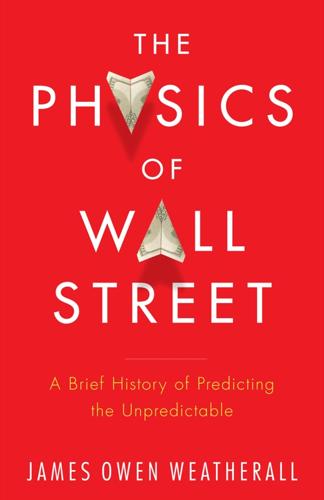
The Physics of Wall Street: A Brief History of Predicting the Unpredictable
by
James Owen Weatherall
Published 2 Jan 2013
Although discussing such debates is far from the scope of this book, I should note that the arguments offered here for how one should think of the status of mathematical models in finance are closely connected to more general discussions concerning the status of mathematical or physical theories quite generally. “. . . named after Scottish botanist Robert Brown . . .”: Brown’s observations were published as Brown (1828). “The mathematical treatment of Brownian motion . . .”: More generally, Brownian motion is an example of a random or “stochastic” process. For an overview of the mathematics of stochastic processes, see Karlin and Taylor (1975, 1981). “. . . it was his 1905 paper that caught Perrin’s eye”: Einstein published four papers in 1905. One of them was the one I refer to here (Einstein 1905b), but the other three were equally remarkable. In Einstein (1905a), he first suggests that light comes in discrete packets, now called quanta or photons; in Einstein (1905c), he introduces his special theory of relativity; and in Einstein (1905d), he proposes the famous equation e = mc2
…
“The Predictors by Thomas A. Bass: A Retrospective.” This is a comment on The Predictors by a former employee of the Prediction Company. Available at http://www.bearcave.com/bookrev/predictors2.html. Karlin, Samuel, and Howard M. Taylor. 1975. A First Course in Stochastic Processes. 2nd ed. San Diego, CA: Academic Press. — — — . 1981. A Second Course in Stochastic Processes. San Diego, CA: Academic Press. Katzmann, Robert A. 2008. Daniel Patrick Moynihan: The Intellectual in Public Life. Washington, DC: Woodrow Wilson Center Press. Kelly, J., Jr. 1956. “A New Interpretation of Information Rate.” IRE Transactions on Information Theory 2 (3, September): 185–89.
…
Journal of Economic Perspectives 12 (1, Winter): 3–26. Bosworth, Barry P. 1997. “The Politics of Immaculate Conception.” The Brookings Review, June, 43–44. Bouchaud, Jean-Philippe, and Didier Sornette. 1994. “The Black-Scholes Option Pricing Problem in Mathematical Finance: Generalization and Extensions for a Large Class of Stochastic Processes.” Journal de Physique 4 (6): 863–81. Bower, Tom. 1984. Klaus Barbie, Butcher of Lyons. London: M. Joseph. Bowman, D. D., G. Ouillion, C. G. Sammis, A. Sornette, and D. Sornette. 1998. “An Observational Test of the Critical Earthquake Concept.” Journal of Geophysical Research 103: 24359–72.

Algorithms to Live By: The Computer Science of Human Decisions
by
Brian Christian
and
Tom Griffiths
Published 4 Apr 2016
Like the famous Heisenberg uncertainty principle of particle physics, which says that the more you know about a particle’s momentum the less you know about its position, the so-called bias-variance tradeoff expresses a deep and fundamental bound on how good a model can be—on what it’s possible to know and to predict. This notion is found in various places in the machine-learning literature. See, for instance, Geman, Bienenstock, and Doursat, “Neural Networks and the Bias/Variance Dilemma,” and Grenander, “On Empirical Spectral Analysis of Stochastic Processes.” in the Book of Kings: The bronze snake, known as Nehushtan, gets destroyed in 2 Kings 18:4. “pay good money to remove the tattoos”: Gilbert, Stumbling on Happiness. duels less than fifty years ago: If you’re not too fainthearted, you can watch video of a duel fought in 1967 at http://passerelle-production.u-bourgogne.fr/web/atip_insulte/Video/archive_duel_france.swf.
…
Discover 6, no. 6 (1985): 40–42. Graham, Ronald L., Eugene L. Lawler, Jan Karel Lenstra, and Alexander H. G. Rinnooy Kan. “Optimization and Approximation in Deterministic Sequencing and Scheduling: A Survey.” Annals of Discrete Mathematics 5 (1979): 287–326. Grenander, Ulf. “On Empirical Spectral Analysis of Stochastic Processes.” Arkiv för Matematik 1, no. 6 (1952): 503–531. Gridgeman, T. “Geometric Probability and the Number π.” Scripta Mathematika 25, no. 3 (1960): 183–195. Griffiths, Thomas L., Charles Kemp, and Joshua B. Tenenbaum. “Bayesian Models of Cognition.” In The Cambridge Handbook of Computational Cognitive Modeling.
…
See Todd and Miller, “From Pride and Prejudice to Persuasion Satisficing in Mate Search,” and Todd, “Coevolved Cognitive Mechanisms in Mate Search.” Selling a house is similar: The house-selling problem is analyzed in Sakaguchi, “Dynamic Programming of Some Sequential Sampling Design”; Chow and Robbins, “A Martingale System Theorem and Applications”; and Chow and Robbins, “On Optimal Stopping Rules.” We focus on the case where there are potentially infinitely many offers, but these authors also provide optimal strategies when the number of potential offers is known and finite (which are less conservative—you should have a lower threshold if you only have finitely many opportunities).
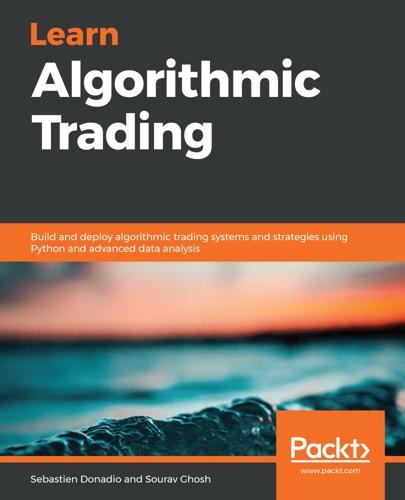
Learn Algorithmic Trading
by
Sebastien Donadio
Published 7 Nov 2019
Predicting the Markets with Basic Machine Learning In the last chapter, we learned how to design trading strategies, create trading signals, and implement advanced concepts, such as seasonality in trading instruments. Understanding those concepts in greater detail is a vast field comprising stochastic processes, random walks, martingales, and time series analysis, which we leave to you to explore at your own pace. So what's next? Let's look at an even more advanced method of prediction and forecasting: statistical inference and prediction. This is known as machine learning, the fundamentals of which were developed in the 1800s and early 1900s and have been worked on ever since.
…
He specializes in statistical arbitrage market-making, and pairs trading strategies for the most liquid global futures contracts. He works as a Senior Quantitative Developer at a trading firm in Chicago. He holds a Masters in Computer Science from the University of Southern California. His areas of interest include Computer Architecture, FinTech, Probability Theory and Stochastic Processes, Statistical Learning and Inference Methods, and Natural Language Processing. About the reviewers Nataraj Dasgupta is the VP of Advanced Analytics at RxDataScience Inc. He has been in the IT industry for more than 19 years and has worked in the technical & analytics divisions of Philip Morris, IBM, UBS Investment Bank, and Purdue Pharma.
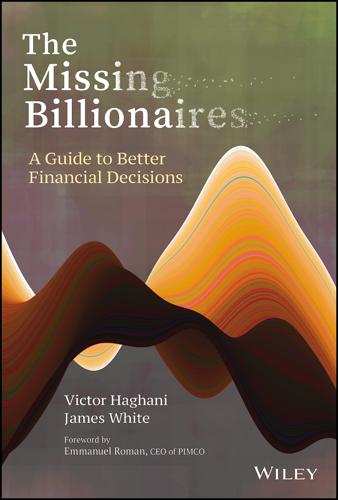
The Missing Billionaires: A Guide to Better Financial Decisions
by
Victor Haghani
and
James White
Published 27 Aug 2023
Triumph of the optimists: 101 years of global investment returns. Princeton: Princeton University Press. Domar, E. and Musgrave, R. (1944). Proportional income taxation and risk‐taking. Quarterly Journal of Economics, 58(3), 388–422. Dubins, L. and Savage, L. (2014). How to gamble if you must: Inequalities for stochastic processes. Dover Books on Mathematics. Duke, A. (2018). Thinking in bets: Making Smarter decisions when you don't have all the facts. London: Portfolio. Duke, A. (2022). Quit: The power of knowing when to walk away. London: Portfolio. Dybvig, P. (1995). Dusenberry's ratcheting of consumption: Optimal dynamic consumption and investment given intolerance for any decline in standard of living.
…
Let's look at three basic betting strategies and see how well they do, always assuming the player bets on heads for every flip: Constant fractional betting, which requires betting the same percentage of the player's current bankroll on each flip. Constant absolute betting, which calls for betting the same dollar amount on each flip. Doubling down betting, originally called the “Martingale system” following its development in eighteenth century France, which doubles the bet size after every loss. The idea is that the first winning bet will recoup all previous losses plus pay out a profit equal to the original stake. We'll assume that a player could make 300 bets over the 30 minutes.
…
., 31–33 Lintner, John, 232, 344n2 Lo, Andy, 32n Log‐utility function, 71 Longevity risk, 167–170, 167e, 168e Long‐Term Capital Management (LTCM), 4–5, 117–126, 179, 230, 333 Long‐term inflation‐linked government bonds, 204 Long‐term tax deferral, 62 LOR, 184, 185 Loss aversion, 109 Lottery, playing the, 105, 261–262, 287–289 LTCM, see Long‐Term Capital Management Macroeconomic models, 190 Madoff, Bernard, 263 Malkiel, Burton, 64, 246 Marginal tax rates, 229 Market timing, 63–64 Markowitz, Harry, 56, 130, 232, 322, 344n2 “Martingale system,” 18 Mayweather, Floyd, 82 Median, 30–33, 91, 114, 152–154, 158 Mehra, R., 292 Mercer, Robert, 45 Meriwether, John, 46–47, 118 Merton, Robert C., 8, 37, 62, 87, 121, 132, 135–136, 151, 158, 160, 243, 348nn2–3, 351n7 Merton optimal spending rule, 158–159, 159e Merton‐Samuelson lifetime consumption and portfolio choice framework, 132–141 Merton share, 10, 37–39, 41–47, 53, 53e, 62–64, 68, 89–92, 136, 186, 206n, 267, 335 “Middle” wealth, maximizing, 30–31, 31t Milevsky, Moshe, 195 Mill, John Stuart, 103, 116 Miller, Merton, 56, 344n2 Modigliani, Franco, 166 Money pump, 96 Monte Carlo simulations, 99, 142, 197 Morgenstern, Oskar, 74–75, 110 Mortgage‐backed securities, 256 Mortgages, 215 Morton, Andrew, 86 Mossin, Jan, 232, 344n2 Municipal bonds, 213 Musk, Elon, 43 Mutual funds, 6, 215–217 Nalebuff, Barry, 196–197 Natural gas, 231 Necktie paradox, 277 Negative risk‐aversion, 109 Negative savings rate, 194 Negative time preference, 189 1929 stock market crash, 208 Nominal government bills and bonds, 204–205 Nonzero interest rates, 292–293 October 1987 stock market crash (Black Monday), 184–185, 207, 249, 290, 313, 315 Odd lot trade, 227 Oil, 231 Options, 197n, 227, 245–264 alternative classes of, 262–263 determining fair price for, 254–256 and equity price drops, 253–254 exotic, 263 hedging, 263–264 interest rate, 256 and life cycle investing, 260 as lottery tickets, 261–262 as portfolio insurance, 251–253 and portfolio rebalancing, 248–251, 248t, 250e selling, 256–260 on single stocks, 260–261 trading in, as zero‐sum activity, 246 trading volume of, vs. stocks, 245 two‐asset case with, 248–249, 248t using Expected Utility with, 247–248 Outlier events, 23 Out‐of‐the‐money call options, 262 Parameter uncertainty, with multiple risky assets, 282–283 Parfit, Derek, 189 Paulson, John, 189n Perold, André, 118n Perpetuities, 299, 300e Perpetuity paradox, 309 “Personal Identity” (Parfit), 189 Personal trading, 63 Personal utility function, 9 Philanthropy, 182–183 Piketty, Thomas, 324 Ponzi schemes, 263 Portfolios: asset mix in, 231–233 options and rebalancing of, 248–251, 248t, 250e Powerball, 288 Present value, of an equity investment, 208 Price of risk, 83–87, 84e Private Placement Life Insurance (PPLI), 272 Professional gamblers, 45 Prospect theory, 109 Put options, 250e, 252, 253n, 256–257 Rabin's calibration paradox, 105 Ragulin, Vladimir, 245n RAR, see Risk‐adjusted return Rate of growth, optimizing the, 38 Rational choice, axioms of, 74 Real, after‐tax income, 335 Real estate, 213–215 Realized gains, 266–268 Real returns, focusing on, 235 Renaissance Technologies, 45 Renting, buying vs., 214 Residential real estate, 213–215 Retirement, 198–199 Return‐chasing, 222 Reverse convertibles, 256 Reward‐to‐variability ratio (R/V ratio), 56–57 Risk(s): and desire, 68–70 of factor investing, 223 importance of calculating, 335 putting a cost on, 337 risk‐adjusted return and price of, 83–87, 84e standard deviation as measure of, 34–35 uncertainty vs., 275–284 Risk‐adjusted return (RAR), 90, 91e, 240–242 endowments, 156–158, 160 ESG investing, 224 factor investing, 219 formula for, 340 importance of knowing, 335 mutual funds, 216 options, 250, 250e, 257, 258 and price of risk, 83–87, 84e and retirement, 135–137 and taxation, 268 Risk‐aversion, 36–38, 41–42, 69, 75–79, 86–87, 105–107, 108n, 109, 113, 114, 179–181, 281, 292, 319, 335.
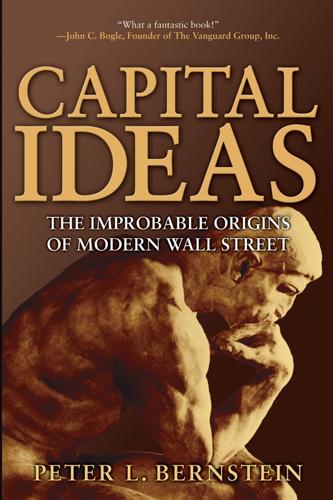
Capital Ideas: The Improbable Origins of Modern Wall Street
by
Peter L. Bernstein
Published 19 Jun 2005
Paul Cootner, one of the leading finance scholars of the 1960s, once delivered this accolade: “So outstanding is his work that we can say that the study of speculative prices has its moment of glory at its moment of conception.”1 Bachelier laid the groundwork on which later mathematicians constructed a full-fledged theory of probability. He derived a formula that anticipated Einstein’s research into the behavior of particles subject to random shocks in space. And he developed the now universally used concept of stochastic processes, the analysis of random movements among statistical variables. Moreover, he made the first theoretical attempt to value such financial instruments as options and futures, which had active markets even in 1900. And he did all this in an effort to explain why prices in capital markets are impossible to predict!
…
(LOR) Leland-Rubinstein Associates Leverage Leveraged buyouts Liquidity management market money Preference theory stock “Liquidity Preference as Behavior Toward Risk” (Tobin) Linear programming Loading charges: see Brokerage commissions London School of Economics (LSE) London Stock Exchange Macroeconomics Management Science Marginal utility concept “Market and Industry Factors in Stock Price Performance” (King) Market theories (general discussion). See also specific theories and types of securities competitive disaster avoidance invisible hand linear regression/econometric seasonal fluctuations stochastic process Mathematical economics Mathematical Theory of Non-Uniform Gases, The Maximum expected return concept McCormick Harvester Mean-Variance Analysis Mean-Variance Analysis in Portfolio Choice and Capital Markets (Markowitz) “Measuring the Investment Performance of Pension Funds,” report Mellon Bank Merck Merrill Lynch Minnesota Mining MIT MM Theory “Modern Portfolio Theory.
…
Speech in Honor of William F. Sharpe. October 17. Leland, Hayne E. and Mark Rubinstein. 1988. “The Evolution of Portfolio Insurance.” Portfolio Insurance: A Guide to Dynamic Hedging, Donald Luskin, ed. New York: John Wiley & Sons, pp. 3–10. Leroy, Stephen F. 1989. “Efficient Capital Markets and Martingales.” Journal of Economic Literature, Vol. XXVII (December), pp. 1583–1621. This article contains an extensive bibliography. Lichtenberg, Frank. 1990. “Industrial Diversification and Its Consequences for Productivity.” Cambridge, MA: National Bureau of Economic Research, Working Paper #3231. Lichtenberg, Frank and Donald Siegel. 1989.